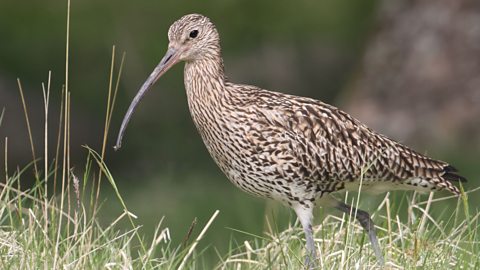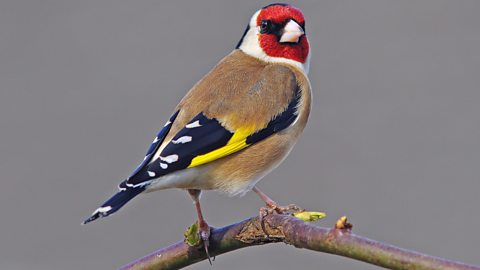Spring is in the air and with it comes the distinctive sound of birdsong everywhere.
But can you tell your robins from your blackbirds? And how many lesser-spotted species can you name?
Here are five rare birds you could get a sneaky peek of in different parts of the UK as summer gets closer.
Little tern, plenty of noise
The coast is a rowdy arena, with enormous, squawking seagulls a constant feature around the UK – not to mention a threat to our fish and chips!
Whereas seagulls are relatively easy to spot, there's another coastal bird worth looking out for which offers impressive aerial displays. Called the little tern, it weighs about as much as a tennis ball – and is our smallest UK tern.

Numbers are in serious decline with fewer than 2,000 breeding pairs in the UK.
Conservation is helping to boost numbers of these expert fishers in a few different ways, such as using decoy birds and recorded calls to encourage them to nest further up beaches and in safer spots.
When can I see them?: April to September.
Where can I see them?: Coastal areas UK-wide. The largest colonies can be found in south and east of England, North Wales, and Scotland’s east and south coasts.
What do they look like?: Mainly white, short tail, black head and a distinctive yellow bill with black tip.
The booming bittern
This shy, secretive, skulking bird lurks in reedbeds nationwide, stalking fish and eels.
Bitterns disappeared in the 1800s before making a comeback in the early 20th Century and numbers are tracked by counting their distinctive ‘booms’ heard in the spring.

To attract females, males crank up a noise of around 100 decibels (just for comparison, standing near speakers at a rock concert would be approximately 115 decibels) which can be heard up to three miles away.
Bitterns are expert at staying absolutely still so are notoriously hard to find – dedicated bird spotters have been known to take out heat sensor equipment to see them, but often to no avail. Good luck!
When can I see them?: All year round.
Where can I see them?: In wetlands with reedbeds. There are specific sites in England, including Leighton Moss in Lancashire, Minsmere in Suffolk and the Wildfowl and Wetlands Trust (WWT) London Wetland Centre. In the winter months, they can also be spotted in north and south Wales and north east Scotland.
What do they look like?: Pale, buffy-brown plumage covered with dark streaks and bars. Large, broad wings, about 1.3m while in flight.
Blink and you may miss the pied flycatcher
These small birds feed their young emerging caterpillars and have razor sharp reactions, favouring oak trees in woodland canopies, where they perch in wait of prey.

They’re impressive migrants too. They arrive from the west coast of Africa for the summer - quite a journey for a bird smaller than a house sparrow. To see one you’ll need patience, a good eye and a comfy perch yourself!
When can I see them?: April to September.
Where can I see them?: Mature woodland in mainly western areas. There are good numbers across Wales in the summer and they can also be seen in north west England and south and mid west Scotland. When migrating (in April and September), they can be spotted on the east and south coasts of England.
What do they look like?: Males have mostly black upperparts and are white underneath, with a bold white patch on the folded wing. Females are more brown.
The cuckoo - an expert in disguise
Remember the sound of a cuckoo clock? Keep your ears open and you might be lucky enough to hear the real thing this summer.
Cuckoo numbers have declined by 60% since the 1960s, making spotting one a rare occurrence – their colours blend in well with branches too.

Cuckoos lay eggs in other birds’ nests, but this takes some serious skill to pull off. They need to choose the right host to accept the eggs, produce eggs that look like those of their hosts, and find birds who will feed their chicks the right food.
When can I see them?: Mid-late April to July. They are one of the first migrants to leave as they have no chicks to bring up.
Where can I see them?: Woodland edges, grassland and reedbeds. UK-wide, but greater populations in southern and central England.
What do they look like?: Similar size to a dove. Blue-grey upper parts, head and chest. Dark barred white under parts.
The curlew comes with its own tweezers
Our largest wader, the curlew has the most charming, evocative call. It also has an instantly recognisable, large curved bill - ideal for sifting through sand and mud for food such as spiders, shellfish and shrimps.

Their bill is so long, the tongue can’t reach the end. Instead, the beak acts like tweezers, plucking food from the ground and throwing it to the side, where it uses its tongue to move the tasty morsels into its mouth.
Although numbers are declining, a quarter of the global curlew population call the UK home. Flocks moving together are quite the sight.
When can I see them?: All year round.
Where can I see them?: In the summer, UK-wide in wet grasslands, farmland, heath and moorlands. In the winter, they can be spotted in coastal areas.
What do they look like?: Really distinctive long beak and legs. Mottled brown and grey plumage. Long, downcurved bill, pink underneath. Blue/grey legs.
Quiz: Learn to spot UK birds using their songs
Help your child learn how to identify British garden and woodland birds from their songs and appearance.

Florrie: bird of prey specialist. video
Florrie runs her own falconry business.

Five ways to make bird watching a fun family activity
The joy of watching birds is that almost anyone can do it with the minimum of effort. Find out how your family can get involved with this Bitesize article.
